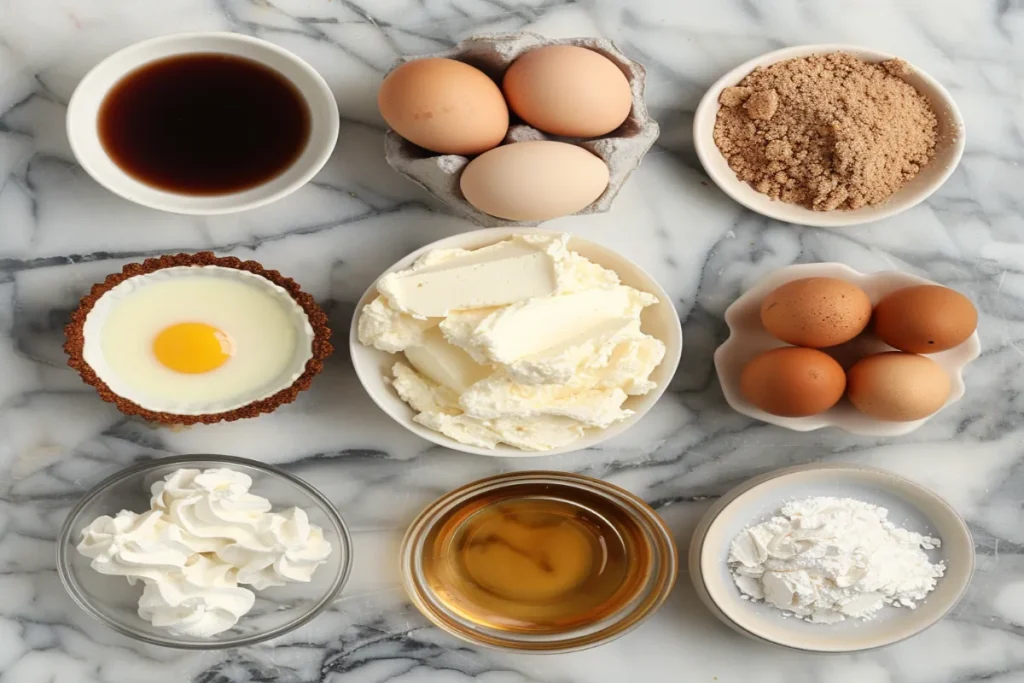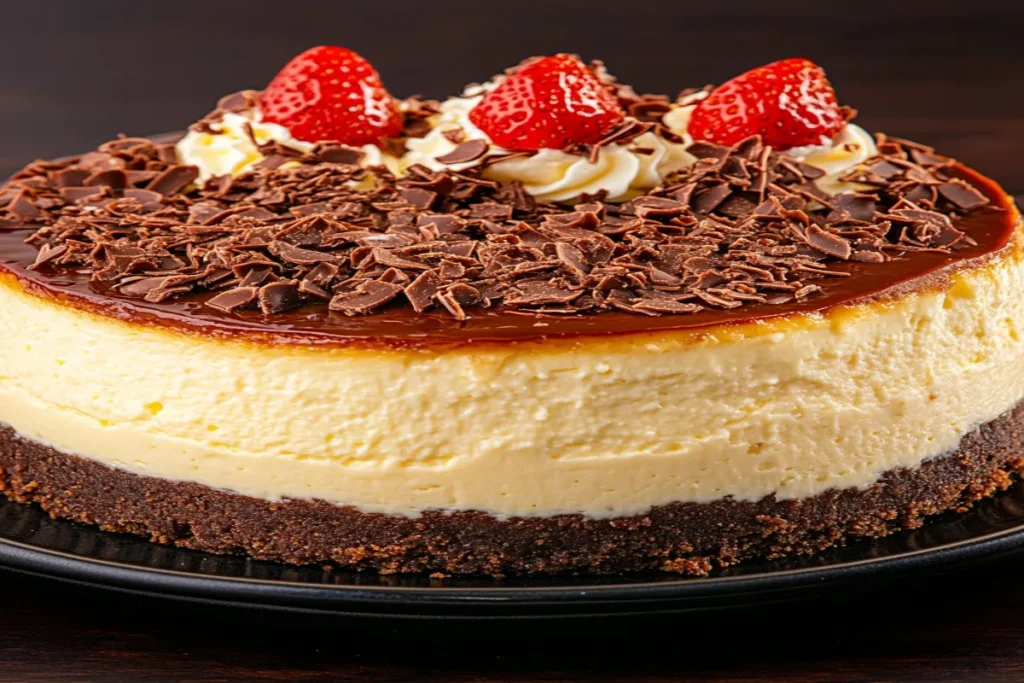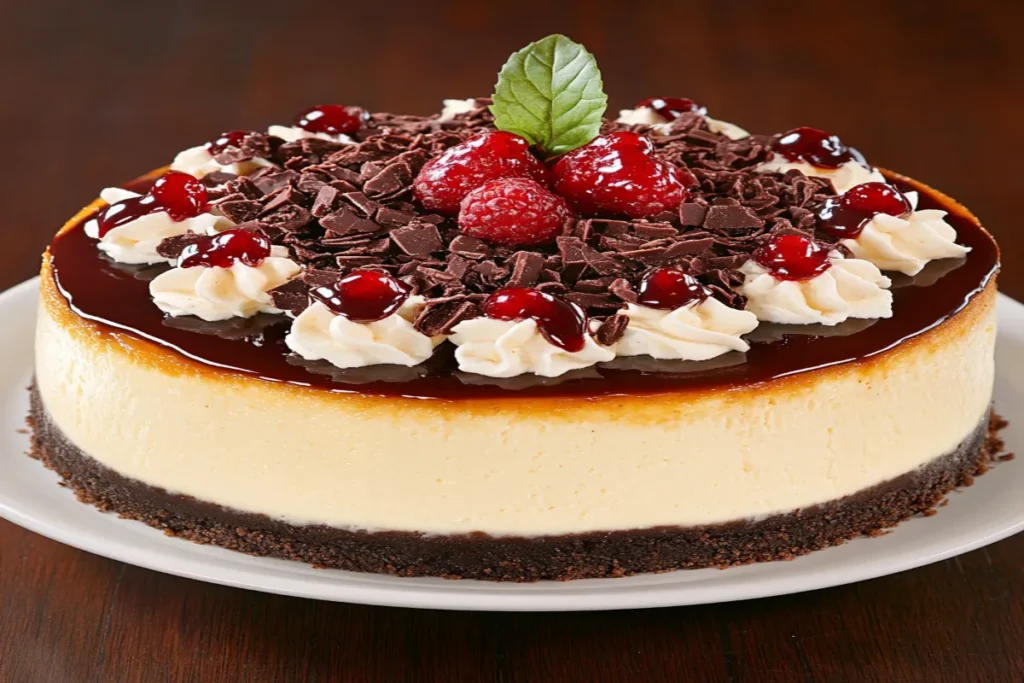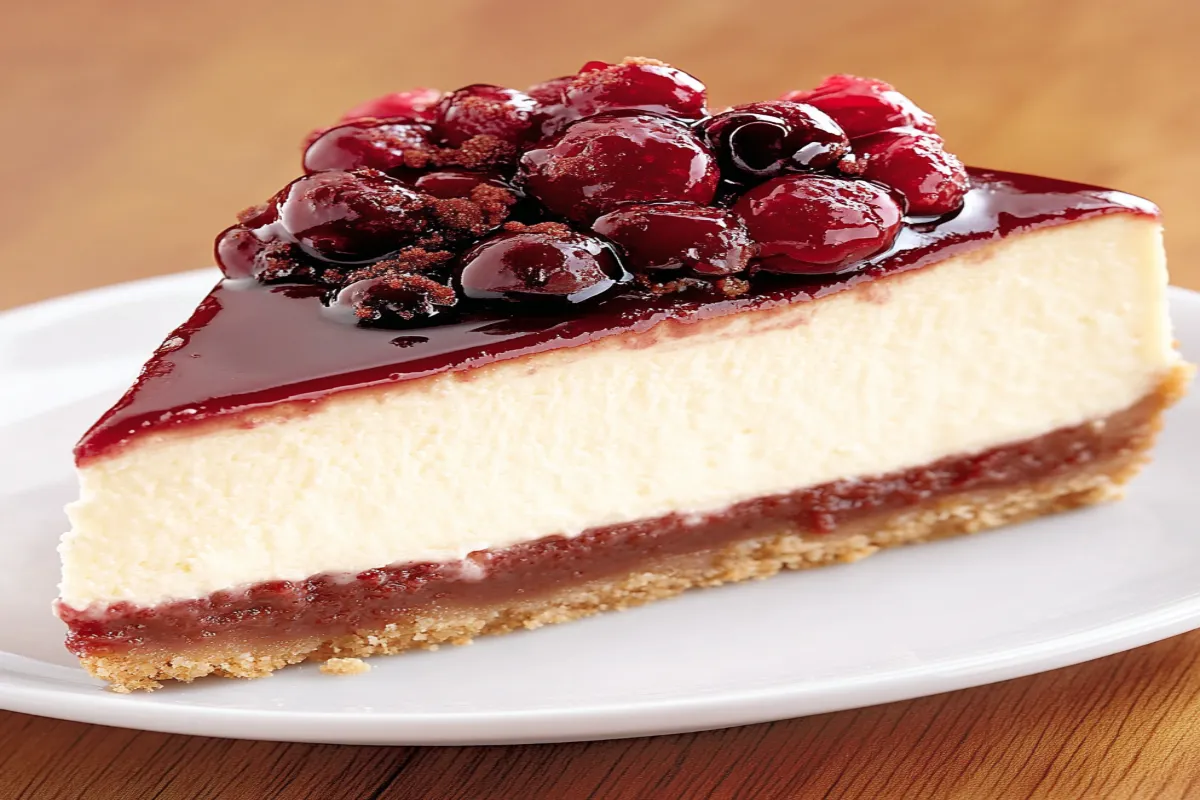The Art of Philadelphia Cheesecake
Philadelphia cheesecake – the mere mention of it evokes thoughts of creamy decadence. But what makes it different from the famed New York style or the traditional Italian version? At its core, Philadelphia cheesecake is cherished for its elegance and the exceptional smoothness created by its key ingredient: Philadelphia cream cheese. This dessert isn’t just a treat; it’s a versatile base for endless flavors, a nod to the beauty of baking, and a timeless favorite.
Essential Ingredients for the Perfect Philadelphia Cheesecake
Creating a flawless Philadelphia cheesecake begins with premium ingredients. Here’s what you’ll need to get started:
- Philadelphia cream cheese, for its signature velvety texture
- Sugar, to add just the right amount of sweetness
- Eggs, to bind everything together
- A hint of vanilla extract for that aromatic depth
- A simple graham cracker crust to form the base

Step-by-Step Philadelphia Cheesecake Recipe
- Prepare the Pan: Grease your springform pan with butter or a quick spray of non-stick cooking spray.
- Make the Crust: Combine crushed graham crackers and melted butter, then press the mixture firmly into the bottom of your pan, creating a solid foundation.
- Mix the Filling: Beat the Philadelphia cream cheese until smooth. Gradually add sugar, then eggs one by one, followed by vanilla extract. The goal is a smooth, lump-free mixture, so be sure not to overmix.
- Bake the Cheesecake: Pour the filling over the crust and smooth the top. For expert tips on achieving the smoothest batter, consider checking out “The Best Technique for Classic Cheesecake,” where you’ll learn about the importance of room-temperature ingredients and using a water bath for the best results.
- Chill the Cheesecake: After baking, let the cheesecake cool slowly, then refrigerate it. The gradual cooling process is key to achieving that perfectly creamy texture.
Tips for a Creamy, Luscious Cheesecake
- Room-Temperature Ingredients: Ensure the Philadelphia cream cheese and eggs are at room temperature before mixing to prevent lumps and achieve a smoother batter.
- Water Bath Magic: Baking your cheesecake in a water bath helps create a moist environment, reducing the risk of cracks and ensuring an even bake.
- Cool Slowly: After baking, let the cheesecake cool in the oven with the door slightly ajar, then transfer it to the fridge to set. This slow cooling method helps preserve the delicate texture.
By following these instructions and helpful tips, you’ll be on your way to creating a Philadelphia cheesecake that’s not just a dessert, but a masterpiece. Stay tuned for the next section, where we’ll dive into creative variations of this classic dessert, showing that Philadelphia cheesecake is as versatile as it is delicious.
Delicious Philadelphia Cheesecake Variations
No-Bake Philadelphia Cheesecake
For those hot summer days or when you simply don’t want to turn on the oven, try a no-bake Philadelphia cheesecake. This variation is quick and easy, relying on a fridge to set the cheesecake. The trick is using gelatin or condensed milk, which helps the cheesecake firm up while keeping its signature smoothness.
Flavorful Variations
Why limit yourself to classic vanilla when you can experiment with exciting new flavors? Philadelphia cheesecake is an excellent base for endless flavor possibilities. Here are some ideas to spark your creativity:
- Strawberry Swirl: Add a homemade strawberry sauce for a sweet and fruity twist.
- Chocolate Delight: Mix in melted chocolate for a rich, indulgent flavor.
- Lemon Zing: Infuse it with fresh lemon juice and zest for a refreshing citrusy flavor.
Seasonal and Festive Variations
Philadelphia cheesecake is a year-round dessert, perfect for adapting to any season or holiday:
- Pumpkin Spice: Ideal for cozy fall get-togethers.
- Peppermint Chocolate: A festive winter treat for the holidays.
- Berry Medley: A refreshing dessert perfect for summer gatherings.
With all these variations, the world of Philadelphia cheesecake is full of endless possibilities, ensuring it remains a beloved classic for every occasion.
Cheesecake Techniques and Tips
Tips for a Smooth and Creamy Texture
We’ve touched on the importance of a smooth texture, but let’s dive a bit deeper. Here are additional tips to ensure your Philadelphia cheesecake is the talk of the table:
- Don’t Overmix: Overmixing can incorporate too much air, leading to a cheesecake that’s prone to cracking.
- Strain the Batter: For an ultra-smooth texture, strain your batter through a fine-mesh sieve before pouring it into the crust.
How to Prevent Cracks in Your Cheesecake
Cracks in cheesecake can be disheartening, but they’re not inevitable. For more in-depth tips on preventing cracks and ensuring a smooth texture, explore Cheesecake Tips and Techniques on Food Network, where you’ll find expert advice on gentle baking and cooling. Here’s how to keep your dessert flawless:
- Avoid Overbaking: The center should be slightly wobbly when you take it out of the oven; it will set as it cools.
- Moist Environment: As mentioned, a water bath can work wonders in keeping the oven moist and the heat gentle.
The Best Baking Tools and Equipment for Cheesecake Making
The right tools can make all the difference in baking. For Philadelphia cheesecake, consider these essentials:
- Springform Pan: A must-have for easy removal without damaging your cheesecake.
- Mixer: A stand mixer or hand mixer to ensure your batter is perfectly smooth.
- Rubber Spatula: To fold in ingredients gently and scrape the bowl clean.
Philadelphia Cheesecake vs. Other Cheesecakes
Comparison with New York, California, and Italian Cheesecakes
Philadelphia cheesecake is known for its creamy, rich texture, primarily due to the use of Philadelphia cream cheese. In contrast:
- New York cheesecake is denser and often includes sour cream or heavy cream.
- California cheesecake tends to be lighter, sometimes incorporating fresh fruit or even a sour cream topping.
- Italian cheesecake traditionally uses ricotta cheese, giving it a slightly grainier texture.
The Role of Philadelphia Cream Cheese
Dive deeper into the unique qualities that set Philadelphia cream cheese apart by visiting Catastrophic Cook, where the focus is on the ingredient’s role in achieving the perfect cheesecake texture. Its smoothness and richness are unparalleled, making it the preferred choice for cheesecake lovers aiming for that perfect creamy consistency.
Cultural and Historical Context
Each cheesecake style reflects its cultural background, from the dense and rich New York version to the airy and light Italian variant. Philadelphia cheesecake stands out for its focus on simplicity and quality, embodying the American love for straightforward, delicious desserts.
Serving and Pairing Ideas
How to Serve Philadelphia Cheesecake
Presentation is key when it comes to serving your Philadelphia cheesecake. A beautifully presented cheesecake not only looks inviting but can also enhance the overall tasting experience. Here are a few tips:
- Slice with Precision: Dip your knife in hot water and wipe it dry between slices for clean, sharp cuts.
- Garnish Galore: Top with fresh berries, a dollop of whipped cream, or a drizzle of caramel or chocolate sauce for an extra touch of elegance.
Pairing Suggestions
For an expert guide on pairing your cheesecake with the perfect wine or coffee, Martha Stewart offers insights into dessert pairings that can elevate your cheesecake experience. Consider these pairing ideas to elevate your cheesecake experience:
- Coffee or Espresso: The bitterness of coffee beautifully balances the sweetness of the cheesecake.
- Dessert Wines: A sweet Riesling or a sparkling Moscato can complement the creamy texture.
- Fresh Fruits: For a lighter touch, pair with seasonal fruits like strawberries or peaches for a refreshing contrast.

Presentation and Decoration Tips
Your cheesecake isn’t just a dessert; it’s a centerpiece. Make it stand out with these decoration tips:
- Edible Flowers: For a touch of sophistication, garnish with edible flowers.
- Chocolate Shavings: Add texture and richness with finely shaved chocolate.
- Sauce Art: Create designs with sauces using a squeeze bottle for an artistic finish.
Health and Dietary Considerations
Lighter and Healthier Versions of Philadelphia Cheesecake
For those mindful of their health or dietary restrictions, fear not! Discover gluten-free crust alternatives and vegan cream cheese options at Catastrophic Cook, providing a path for everyone to enjoy Philadelphia cheesecake regardless of dietary restrictions:
- Use Low-Fat Cream Cheese: Opt for low-fat or light Philadelphia cream cheese to reduce the calorie count.
- Alternative Sweeteners: Consider using alternative sweeteners like stevia or monk fruit to lower the sugar content.
- Add Fruits: Incorporate fresh fruits not only as a topping but also mixed into the batter for natural sweetness and flavor.
Gluten-Free and Vegan Options
- Gluten-Free Crust: Use almond flour or gluten-free graham crackers for the crust to make it accessible to those with gluten sensitivities.
- Vegan Variations: There are now vegan Philadelphia cream cheese alternatives available that work wonderfully in cheesecake recipes, along with plant-based milk and egg substitutes.
Nutritional Information and Benefits
While Philadelphia cheesecake is undoubtedly a treat, incorporating ingredients like fresh fruits or opting for lighter versions can offer some nutritional benefits, such as vitamins from the fruit and reduced fat from lighter cream cheese options.
FAQs
What is the difference between New York cheesecake and Philadelphia cheesecake?
The main difference lies in the texture and ingredients. Philadelphia cheesecake is celebrated for its creamy, smooth consistency, primarily due to the use of Philadelphia cream cheese. New York cheesecake, on the other hand, is denser and richer, often incorporating heavy cream or sour cream to achieve its characteristic texture.
Can I use Philadelphia instead of cream cheese?
Absolutely! In fact, Philadelphia cream cheese is the preferred choice for many bakers seeking to achieve the classic, creamy texture of Philadelphia cheesecake. Its quality and consistency make it an ideal ingredient for cheesecakes.
What is the difference between New York cheesecake and California cheesecake?
While New York cheesecake is known for its dense, rich texture, California cheesecake tends to be lighter and may include fresh fruits or a sour cream topping, reflecting the state’s abundant produce and preference for fresher, lighter desserts.
What is the difference between New York cheesecake and Italian cheesecake?
Italian cheesecake traditionally uses ricotta cheese, giving it a slightly grainier texture and a less sweet flavor compared to the cream cheese-based New York style. The choice of cheese significantly influences the texture and taste of the final product.

Conclusion: A Celebration of Philadelphia Cheesecake
As we wrap up our culinary journey through the world of Philadelphia cheesecake, it’s clear that this beloved dessert is more than just a treat; it’s a versatile canvas for creativity, a bridge between traditions, and a testament to the simple joy of baking. From its creamy, dreamy base to the endless possibilities for flavors, toppings, and pairings, Philadelphia cheesecake invites both novice bakers and seasoned chefs to explore the depths of their culinary imagination.
The Art of Cheesecake Making
Making a Philadelphia cheesecake is an art that combines precision with passion. It’s about understanding the delicate balance of ingredients, mastering the techniques to achieve that perfect creamy texture, and adding your personal touch to create a dessert that’s uniquely yours. Whether you’re drawn to the classic simplicity of the original or excited to experiment with new variations, the process of making cheesecake is a rewarding adventure in its own right.
A Dessert for Every Occasion
Philadelphia cheesecake has the remarkable ability to fit into any setting: it’s as much at home on a festive holiday table as it is being enjoyed as a casual treat on a weekday. It can be dressed up with gourmet toppings for special occasions or kept simple and straightforward for an anytime indulgence. This versatility makes it a perennial favorite, cherished by dessert lovers across the globe.
The Joy of Sharing
Perhaps the most beautiful aspect of Philadelphia cheesecake is its capacity to bring people together. Sharing a slice of cheesecake is not just about sharing a dessert; it’s about sharing moments, creating memories, and connecting over the universal language of food. Whether it’s a family gathering, a special celebration, or a quiet moment of solitude, Philadelphia cheesecake has a way of making it all the more special.
Looking Forward
As we continue to explore and innovate within the realm of cheesecakes, the future looks bright with delicious possibilities. The tradition of Philadelphia cheesecake will undoubtedly evolve, incorporating new flavors, techniques, and dietary considerations. Yet, at its core, it will always remain a beloved classic, cherished for its simplicity, elegance, and the sheer joy it brings to both the baker and those lucky enough to enjoy a slice.
So, here’s to Philadelphia cheesecake—a dessert that captures the heart, delights the taste buds, and celebrates the joy of baking. May your baking adventures be sweet, your cheesecakes creamy, and your moments of sharing filled with happiness
